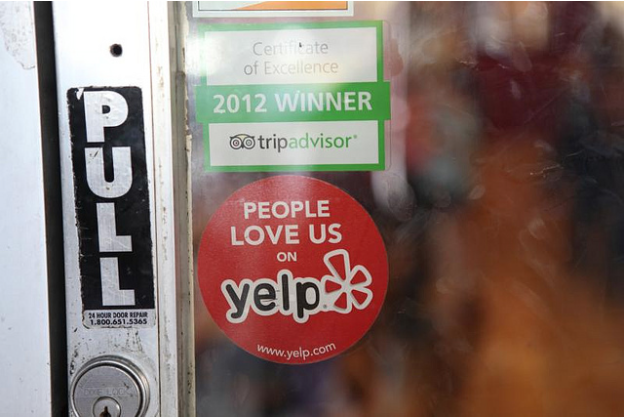
(Source: Flickr)
It’s impossible to please everybody. However, knowing that doesn’t mean it’s easy to deal with unhappy customers who complain or post negative reviews about your restaurant. Dealing with unhappy customers is one of the less desirable parts of owning a restaurant, but unfortunately, as time goes on and you have more customers coming through the door, it’s inevitable from time to time.
While you can’t always control how customers receive your food and service, you can control how you respond to their reactions. The ability to maintain your integrity when responding to negative reviews or unhappy customers will speak volumes about your restaurant. Here, we’ll evaluate how to properly and effectively respond to unhappy customers in a way that might have positive lasting results.
Read the full review, or listen to the full complaint. This is the first step toward responding to an unhappy customer, and it’s one of the most difficult parts of the process. Before even thinking about responding, be sure to absorb the complaint in its entirety.
Most negative reviews are posted online, so this would most likely mean reading the negative review. Luckily, reading a review doesn’t require an immediate response. That means that if the complaint or review makes your blood boil, you can take a break and come back to it. But be sure to read the review in its entirety first thing, because this will not only inform how you respond, but how you can ultimately deal with the situation in hopes of making it better. If your customer is complaining in person, be sure to hear them out entirely before responding.
Whether reading or listening, bserve the facts, the tone and the content of the complaint. When did the customer’s visit or visits take place? Does the customer sound frustrated and angry, or sad because they felt ignored? And importantly, what happened that made their experience a bad one?
Take a short break. If at all possible, after absorbing the complaint, take a short break to reflect. If you’re listening to a complaint in person, take a few deep breaths; if reading a negative review, walk away from your computer for a few minutes. Negative feedback can feel awfully personal, and there can be a powerful urge to respond in a defensive way.
Resist the temptation to respond in anger. Taking a few moments before responding can help you gain clarity and calm which will allow you to respond in a far more respectful and gracious way, which will allow you to maintain an air of professionalism.

(Source: Flickr)
Consider your options. Now that you’ve got a little bit more clarity, consider the complaint again. Considering the customer’s experience factually, do you think it’s something that you can make better? Or do you think that this is the type of thing where you’ve lost the customer and it’s better to simply cut your losses? This can help inform how you respond to the customer in question.
Research the customer’s visit from your staff’s point of view. Be sure to do your homework before responding to the customer in question. For instance, if the complaint indicated that staff was rude or that the food was poorly made or presented, talk to the staff that you think might have been part of the experience. To the best of your ability, try to discern the validity of the complaint.
For instance, if your overloaded chef had just worked three double shifts in a row and just had a bad breakup and the food wasn’t delivered in top form, it doesn’t necessarily forgive their actions, but it can help explain them as an anomaly versus chronic bad behavior.
(Source: Flickr)
Research the customer. Try to see who this customer is, exactly. Are they a regular? Or are they an out-of-towner? If a customer is a local and a regular, offering freebies can be very effective in your response, but the same offer may be cold comfort to a customer who might not be back in the area any time soon.
If the unhappy customer posted an online review, check them out on social media to make sure they are a real person (sometimes, competitors aren’t above posting fake bad reviews!). If they have a profile on the site where the review was posted, read their other reviews. If they are constantly snarky or mean, that may help you understand the personality of the person and inform how you respond.
Try to understand the customer’s point of view. Ooh, this one can be hard, but as much as you can, try to see the issue from the customer’s point of view. Put yourself in their shoes and try to empathize with them. By trying to understand their point of view, you might have better insight as to how you’d like to be responded to if you were in their position, and to understand why this experience was negative for them.
Apologize. Now that you’ve absorbed the complaint, considered it, and researched the issue, it’s time to respond. Take the high road. Start by thanking them for visiting your establishment, and apologize that they had a bad experience.
Even if you completely disagree with their complaint or negative review, you can do both of these things without feeling as though you’ve “given in”.
Why so? The fact is, they were a paying customer and spent money in your establishment, which you should be thankful for. And they did have a negative experience, which is not what you ever want, so it is appropriate to apologize for the fact that they had a bad experience, if not necessarily admitting your guilt.
Offer a solution. Now for the real substance of your response: the solution. If the complaint seemed like something that you could easily remedy, offer what you deem a reasonable solution. For instance, if the customer complained that the bread was cold and that the server was rude and not worthy of a tip, but you really don’t think that these are generally problems in your restaurant, offer them a free meal at your establishment and see if their return visit is more positive. That might help transform them from a customer who won’t make a return visit to a bona fide regular.
On the other hand, if you think that the customer is absolutely inconsolable, you can still thank them for visiting and apologize that they had a negative experience, but don’t push it or hope for miracles. Simply assure them that you are using their feedback to improve your restaurant, and then–most importantly–live up to your promise!
Don’t engage more than necessary. Sure, it can be amusing when a chef has a heated argument with a client, or when a restaurant engages in a Twitter war with a customer over their experience. But is it professional? No way. While it can be tempting to start a fight when a customer has negative feedback, it’s a far wiser decision to take the high road and keep your responses professional, and if things get nasty, to stop engaging with the customer in question. Chances are, they’re not your target customer anyway, and don’t warrant all that much of your time and attention!

(Source: Flickr)
Use this experience to make your restaurant even better. It’s not easy to accept criticism of your restaurant, especially when operating it is your life’s work. However, when you really think about it, negative reviews can be used to improve your restaurant.
Even if you deem a customer’s negative review “unfair”, there may be points in it that you can address with your staff and offerings so that you don’t have a repeat of what was a bad experience to your customer. By taking the time to really evaluate bad reviews and see where they leave room for growth, you have an opportunity to strengthen your business and improve the customer experience. Don’t squander this opportunity!
Conclusion: It’s a simple fact: as your restaurant’s clientele builds, you’re bound to experience a negative review or two. As the restaurateur, it’s your responsibility to respond in a way that maintains the integrity of your establishment. By taking the time to follow these steps in responding to negative customer reviews, you’ll be able to respond in a way that is professional. You might not always win back a customer who has had a bad experience, but it can help you treat customers better moving forward.
How do you respond to negative reviews?



